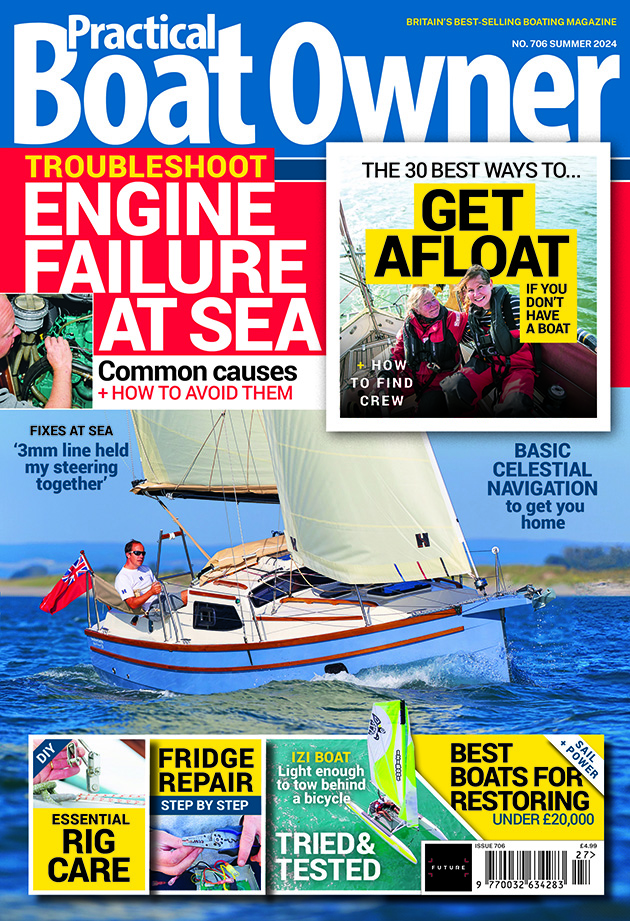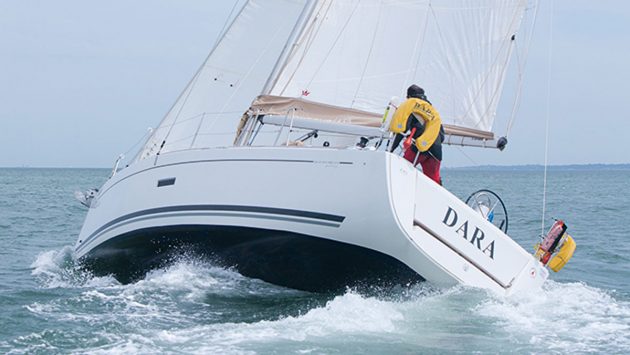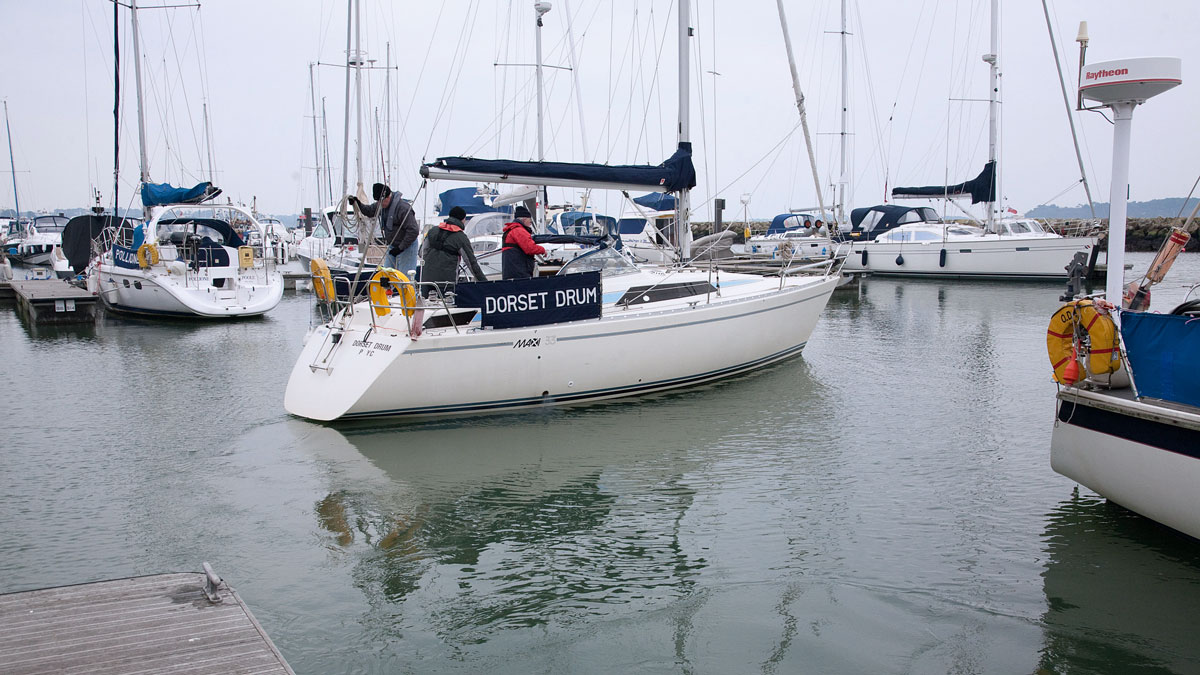When the breeze picks up, how do you stop your boat taking charge and going where it wants? David Harding offers some suggestions for staying in control
Most helmsmen have experienced that feeling of losing control: the moment when the boat decides it’s going to disregard orders from the rudder, known as broaching.
A mild broach might be a momentary distraction. A bigger one can have more significant consequences; potentially even a collision if you happen to be close to something else.
During a breezy Round the Island Race many years ago, a port-tacker broached across the bow of the starboard-tack boat on which I was racing, giving us nowhere to go.
We had a dented stem. The broacher headed for the beach to avoid heading for the bottom in 50ft of water.

This Westerly was beating when, hit by a gust, it broached and ended up with the headsail aback. Credit: David Harding
That feeling when the rudder stops working is likely to be more familiar to owners of race boats than to cruisers, because they’ll be pushing that much harder, and to those who sail beamy, shallow-draught, high-volume cruisers with broad sterns than to those accustomed to slimmer, deeper-hulled classics.
These are generalisations, but the design of the boat has a major bearing on its tendency to broach.
If you own one that’s prone to broaching by virtue of its design, however, there’s plenty you can do to help keep it on the straight and narrow.
For the purposes of this feature, broaching encompasses griping – a more traditional term used to describe a boat’s tendency to round up when sailing on the wind.
Here we’re looking at involuntary rounding up, whatever your chosen terminology, under white sails.
What causes broaching?
The list of factors that make a boat want to turn one way or the other is so long that you might wonder how boats ever sail in a straight line.
They manage because, most of the time, the rudder is big enough to compensate.
Sometimes, however, other factors are more powerful than the rudder, and that’s when you lose control.
Let’s take a look at them.
Broaching: Heel
Heel tends to be the most powerful influence for a number of reasons.
You have only to shift your weight to one side or the other in a tender powered by oars or an outboard to see that heeling to port makes it turn to starboard and vice versa.
Broadly speaking, the beamier the boat the greater the effect of heel.
It’s often thought that, if you’re hit by a gust, easing the main sheet or dropping the traveller will be enough to balance the helm because the headsail is forward of the boat’s centre of lateral resistance (CLR).

Heeling to port induces a turning moment to starboard, and vice versa
It often is enough, but there comes a point beyond which heel is the dominant influence, no matter which sail is inducing it.
Heel affects balance for several reasons.
When a hull is upright, its underwater sections are symmetrical about the centreline.
When it heels, they’re not, and that asymmetry in itself is one factor.
Particularly on boats with broad sterns, heeling causes the stern to lift and the bow to go down, so the CLR moves forward (we’ll look in more detail shortly at centres of effort and lateral resistance).
Then there’s less rudder in the water, and the part that’s working is operating at a less efficient angle.

Rounding-up moment increasing with heel. The diagram on the left shows light winds – gentle heel; the right, strong winds – excessive heel
Even if still fully immersed, a rudder that’s inclined at 50° won’t be particularly efficient: the further it is from the vertical, the less its effect.
Yet another heel-related element is the movement of the rig’s centre of effort (CE) to leeward of the hull’s centre of gravity at the same time as the CLR moves to windward.
This generates a rounding-up moment on top of all the others.
When a boat is on a reach with its sails eased, the centre of effort is further to leeward and the rounding-up moment correspondingly greater than when it’s sailing upwind. That’s why boats generally carry more helm on a reach than on a beat.
Broaching: Sail trim and CLR
A boat’s CLR is the point about which it pivots, as determined by the hull lines and the position of the foils (the keel and, to a lesser extent, the rudder), plus the skeg if there is one.
How the CLR relates to the rig’s centre of effort is critical.
The designer will usually draw the lines so the CE is slightly forward of the CLR, to help offset the rounding-up moment generated by the factors already described.
In theory, most boats should carry lee helm when upright in very light airs, and some do – especially beamy boats where the CE is well forward of the CLR to compensate for their tendency to develop substantial weather helm as they heel.
These boats often need to be heeled deliberately until the breeze picks up, because lee helm is horrible (and slow).

Sail trim and CLR: Diagram on the left: The centre of effort (CE) is usually forward of the centre of lateral resistance (CLF). Middle diagram: If the headsail isn’t driving, the CE moves abaft the CLR and encourages the boat to turn towards the wind. Diagram right: If the headsail is doing all the work, the CE moves forward of the CLR and encourages the boat to turn away from the wind
Broadly speaking, the greater the proportion of the sail area forward of the CLR, the greater the lee-helm tendency – or the less the weather helm.
It follows that, if you reef by reducing the size of the headsail while keeping the full mainsail, you might expect weather helm to increase.
Conversely, reefing the mainsail while hanging to the full headsail might be expected to reduce weather helm.
This is true to a certain extent and on some boats, but there are too many variables to go into here and many modern cruiser/racers hang on to their full mainsails in almost any weather.
How to go about shortening sail efficiently is a subject in its own right.
The fundamental point to bear in mind is that the mainsail, and especially its leech, has a rounding-up influence, being abaft the CLR, while the headsail will encourage the boat to bear away.
An over-sheeted mainsail induces weather helm, applying too much pressure abaft the CLR as well as causing excessive heel and slowing the boat down by increasing sideways force: the closer a sail is to the centreline, the greater the sideways force in relation to the forward drive.
Extra heel and weather helm mean that more rudder angle is needed, which combines with the other factors to slow the boat down and, in so doing, reduce the effectiveness of the foils.
It’s a balancing act with a multitude of interacting elements: one thing inevitably leads to another.
CLR and how to move it
Since the boat’s designer determines where the keel and rudder are fitted, you might imagine there’s not a lot you can do about the CLR – but you can still have an effect.
Most obviously, a swing keel – as on a Southerly, for example – can be partially raised to move the CLR aft.
Of course, this is safe to do only if, as on the Southerlys, the centre of gravity remains low enough for stability.
Of more relevance to owners of any boat is fore-and-aft weight distribution.

Moving weight towards the boat shifts the CLR forward (left)….while moving it towards the stern shifts the CLR aft (right)
Next time you’re sailing upwind in reasonably light conditions, try getting the boat balanced so it’s carrying next to no helm, or ideally sailing itself.
Then send all your crew to the foredeck and note the increase in weather helm.
Next, move them all to the aft end of the cockpit and the boat will either try to bear away or, at the very least, it should lose much of its weather helm.
This demonstrates the effects of fore-and-aft weight distribution.
Moving weight forward immerses the forward part of the hull and lifts the stern, thereby moving the CLR further forward.
Moving weight aft has the opposite effect.
If, therefore, you always notice significant weather helm, it might be worth considering what you can do about weight in the bow, whether it’s the anchor and ground tackle, a full water tank or that bow thruster you just fitted.
Broaching: Sails
We have already looked briefly at sail trim in terms of which sail does what, but a general point to make is that a rig that’s poorly set up or sails that are old or badly trimmed are likely to increase weather helm and, therefore, broaching tendency.
Excessive fullness in the sails, or draught that’s too far aft, will increase heel and sideways force.
The message is that careful attention to rig tuning and keeping your sails in shape will have a major part to play in keeping your boat fast, well balanced and pointing in the right direction.
Other factors
To help your rudder work as well as possible, keep it clean and fair and make sure the leading and trailing edges are smooth.
On many boats a fixed propeller will send turbulence over the rudder, reducing its efficiency.
If you’ve been considering a folding or feathering alternative, here’s another reason to get it.
Telltale signs
Weather helm is easy to see and usually easy to feel with a tiller. As a tiller moves further from the centreline, you need to be ready to ease the sheet.
Stopping the broach
No matter how well the boat is set up, it often takes nothing more than a gust of wind, awave or a lapse of concentration to send it into a broach.
That’s when the helmsman or one of the crew needs to ease the mainsheet or the traveller – quickly.
The kicker controls leech tension and is a useful release valve on a reach.
If the mainsheet is in the cockpit, close to the tiller or wheel, the helmsman can normally reach it.
With the sheet on the coachroof, as on many modern cruisers, it’s down to one of the crew, making short-handed sailing a riskier and more awkward business.
Broaching in practice
Hunter – The wrong way…

Credit: All photos David Harding
1. Here the Hunter is sailing upwind with the mainsheet tight, the boom close to the centreline and the mainsail’s leech closed.
The resulting weather helm can be seen from the angle of the rudder and tiller, even though the boat is not heeling excessively.

2. It only takes a slight increase in wind and, with no adjustment to the sails, the helm loads up substantially.
This is hard work for the helmsman, as well as slow – just look at the turbulence from the rudder.

3. It’s all thoroughly undramatic and the boat adopts no alarming angle of heel, but the rudder loses grip and the next second the boat is almost head-to-wind. She could easily end up on the other tack.
…the right way

Credit: All photos David Harding
1. The Hunter has no traveller, so the mainsheet is eased while the kicker is kept tight, moving the boom further from the centreline without inducing excessive twist (opening the leech too far).
It doesn’t matter that the luff of the mainsail is lifting, because the boat is better balanced and sailing faster like this.

2. When a gust comes along, the skipper applies more helm to keep the boat on track, but the difference this time is that he eases the sheet smartly to stop the boat rounding up.

Another way to help keep control is to reef the mainsail. In marginal conditions and downwind you will be underpowered much of the time, but it will reduce the likelihood of a broach. It’s playing ultra-safe (above)).
Dufour – the wrong way…

1. Like the Hunter, the Dufour has no traveller so the mainsheet is the throttle and the brake. Here she’s right on the edge of being overpowered.

2. There’s no tiller to indicate rudder angle, but the rudder blade is being dragged sideways, leaving an enormous hole in the water.

3. When a boat has started rounding up into a full-on broach like this, there’s no way back.

4. Now she’s approaching head-to- wind and, if the crew don’t act quickly, she’ll be blown round on to the other tack.
…the right way

1. This is getting close to the edge and the rudder is struggling for grip…

2… but, just as she begins to round up, the helmsman dumps the mainsheet to stop her going head to wind.
It’s damage limitation at this stage, not prevention, but the important thing when a boat is close to being overpowered is to be ready to release the sheet.
Continues below…
Boat hull design: how it impacts performance
Peter Poland explains how boat hull design has evolved over the years and how it affects boat handling and accommodation
5 tips for sailing in strong winds
Rupert Holmes has sailed more than 85,000 miles, including the Southern Ocean. He shares his tips for sailing in strong
Berthing a boat using wind and tide
Manoeuvring a boat into and out of a berth is one of the most frequent handling challenges facing boat owners…
Cruising chute or spinnaker? We compare both sails on the same boat on different points of sail
Many cruising sailors favour a cruising chute over a spinnaker – but how do the two sails compare on different…
Enjoy reading Broaching on a boat and how to prevent it?

A subscription to Practical Boat Owner magazine costs around 40% less than the cover price.
Print and digital editions are available through Magazines Direct – where you can also find the latest deals.
PBO is packed with information to help you get the most from boat ownership – whether sail or power.
-
-
-
- Take your DIY skills to the next level with trusted advice on boat maintenance and repairs
- Impartial in-depth gear reviews
- Practical cruising tips for making the most of your time afloat
-
-
Follow us on Facebook, Instagram, TikTok and Twitter








